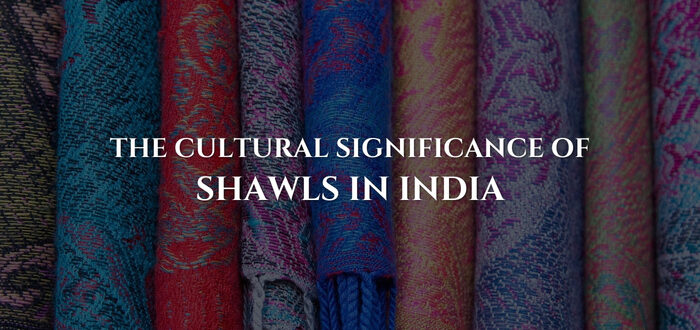Woven Stories: The Cultural Significance of Shawls in India
Shawls are more than just fabrics draped for warmth; they embody India’s unique heritage, with each expressing a story about the people, culture, and history they represent. Shawls in India vary in style, technique, and symbolism, with each region contributing a distinctive component to this rich tapestry. The lavish Kashmiri pashmina, noted for its unparalleled softness and beautiful embroidery, exemplifies centuries-old workmanship, whilst the Naga shawls’ strong patterns represent warrior traditions and ethnic identity. In Punjab, Phulkari shawls feature beautiful flower embroidery that represents festivities and blessings. Shawls are firmly interwoven in Indian life rituals and customs, from ceremonial to everyday usage.

Weave of India’s Heritage and Elegance
Indian shawls have long been seen as a symbol of India’s rich cultural heritage and workmanship, earning international respect and admiration. These stunning pieces of craftsmanship not only demonstrate the skills of Indian weavers but also showcase the country’s different regional textile traditions. Indian shawls are known for their elaborate designs and luxury fabrics such as Pashmina, wool, and silk, and they have grabbed the hearts of both fashion enthusiasts and art collectors.
The timeless appeal of Jamawar shawls, the wonderful softness of Pashmina, and the vibrant colours and complex designs of Kani shawls have all contributed to their global reputation. Indian shawls have evolved to represent a blend of sophistication and heritage, spanning borders and becoming an international symbol of beauty. Today, they are proud symbols of India’s rich cultural heritage, renowned for their creativity and workmanship around the world.
Shawls and dupattas are still classic and important in today’s fashion as the Indian style is being influenced by the West. These classic pieces add a touch of elegance to daily jeans and t-shirt combinations, making them a stunning match for modern ensembles. This blending of cultures produces a distinctive combination of East and West, demonstrating how traditional clothing may coexist peacefully with contemporary styles.
Also Read: The Timeless Treasures of Indian Shawls
The Art of Shawl Making In India
Winter has a profound impact on daily living in many rural areas across India. While much of the year is spent farming and tending to animals, winter’s heavy snowfall can make outside work difficult. This seasonal transition encourages people, particularly women, to seize new opportunities for employment and creativity.

As the colder months arrive, many women devote their focus to the skilled craft of shawl creation. They use traditional handlooms or hand-knitting processes to make stunning outfits that reflect their cultural history. Despite technological improvements, these time-honored methods are still widely used, allowing artists to stay connected to their roots.
A Gift of Respect and Warmth
In India, giving a shawl has great meaning and serves for an array of reasons, including expressing respect and gratitude, conveying affection, and establishing connections. Shawls are frequently used as symbols of warm hospitality, especially when welcoming guests into one’s house or honouring VIPs and dignitaries on important occasions. Their rich history and cultural significance make them an appropriate choice for honouring cherished individuals or those held in high regard.
Shawls have spiritual importance in Tibetan Buddhism, particularly in North and Northeast India, in addition to their use as personal gifts. In Buddhist temples, followers frequently seek blessings from monks by receiving a “khata,” or ceremonial scarf. This sacred shawl represents peace, compassion, and heartfelt wishes for happiness and prosperity, emphasizing the profound cultural traditions around shawl gifting in India.
Wrap yourself in timeless luxury
Symbol of Blessings & Unity In Weddings
India’s weddings would not be the same without the shawl, which has several uses beyond aesthetics. The shawl, which has great cultural value and symbolism, represents custom, safety, and blessings throughout the wedding ceremony.
Both brides and grooms wear shawls, and they frequently highlight the exceptional craftsmanship of local artists through their breathtaking designs, brilliant colours, and delicate stitching. The shawl serves as a means of physical communication between the couple during many rituals. In a custom known as “Granthibandan,” the groom’s shawl is attached to the bride’s garment or shawl, signifying the unbreakable bond that is being formed.

Shawls are an important part of Indian pride and culture, representing many aspects of culture and customs. Their adaptability to both traditional and modern clothes, Indian weddings, and gift-giving makes them a symbol of the country’s rich artistic skill and cultural legacy. Shawls have developed into timeless representations of India’s unique character as they adjust to contemporary fashion trends while maintaining their cultural significance. Ultimately, shawls are more significant in India than just being fashionable; they symbolise the country’s rich cultural heritage, values, and dynamic past.
Discover the elegance of Indian textiles at Giftex’s upcoming auction, featuring an exquisite selection of shawls that reflect our rich heritage. These beautifully crafted pieces showcase the artistry and traditions of skilled artisans, making them not just garments, but cherished symbols of culture and craftsmanship. Join us to explore the luxurious Pashmina, intricate Jamawar, and vibrant Kani shawls, each offering a unique blend of beauty and significance.

Don’t miss this opportunity to add these timeless treasures to your collection or to gift someone special a piece of India’s artistic legacy.






